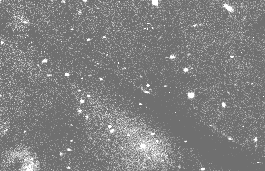

These NTT images are the last that could be obtained using this telescope before the first fragments start to hit Jupiter. The comet is now so stretched that several images are required to cover the full train and the leading fragments are too close to the planet to be seen at all. The proximity of the planet means that the images are dominated by scattered light which is in places saturating the CCD chip. As a result subtracting the background light becomes extremely difficult and this explains the strange features seen on these frames - they are not real!
This image was taken by Pierre Dubath (Lick Observatory, USA and Geneva Observatory, Switzerland) using the New Technology Telescope (NTT) with the RILD CCD system and a red (R) filter. They were all taken close to July 15.0, 1994. The background has been subtracted using a low-pass filtering method.
This image shows fragments E,F,G and H, stretching from upper left to lower right. F is rather faint and small, G is double and just beneath a star. This is a 10 minute exposure